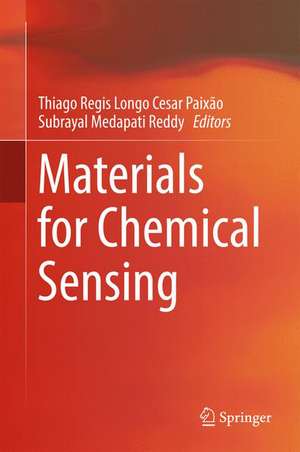Materials for Chemical Sensing
Editat de Thiago Regis Longo Cesar Paixão, Subrayal Medapati Reddyen Limba Engleză Hardback – 30 noi 2016
| Toate formatele și edițiile | Preț | Express |
|---|---|---|
| Paperback (1) | 943.73 lei 6-8 săpt. | |
| Springer International Publishing – 28 apr 2018 | 943.73 lei 6-8 săpt. | |
| Hardback (1) | 949.73 lei 6-8 săpt. | |
| Springer International Publishing – 30 noi 2016 | 949.73 lei 6-8 săpt. |
Preț: 949.73 lei
Preț vechi: 1158.20 lei
-18% Nou
Puncte Express: 1425
Preț estimativ în valută:
181.73€ • 190.13$ • 150.96£
181.73€ • 190.13$ • 150.96£
Carte tipărită la comandă
Livrare economică 02-16 aprilie
Preluare comenzi: 021 569.72.76
Specificații
ISBN-13: 9783319478333
ISBN-10: 3319478338
Pagini: 381
Ilustrații: IX, 268 p. 126 illus., 98 illus. in color.
Dimensiuni: 155 x 235 x 18 mm
Greutate: 0.57 kg
Ediția:1st ed. 2017
Editura: Springer International Publishing
Colecția Springer
Locul publicării:Cham, Switzerland
ISBN-10: 3319478338
Pagini: 381
Ilustrații: IX, 268 p. 126 illus., 98 illus. in color.
Dimensiuni: 155 x 235 x 18 mm
Greutate: 0.57 kg
Ediția:1st ed. 2017
Editura: Springer International Publishing
Colecția Springer
Locul publicării:Cham, Switzerland
Cuprins
Introduction of Materials Used in Chemical Sensors.- Information Extraction Techniques in Chemical Sensing.- (Bio)Chemical Sensors Based on Paper.- Membrane Technologies for Sensing and Biosensing.- Interfacing Graphene for Electrochemical Biosensing.- Nanomaterials as Implantable Sensors.- Self-assembly Thin Films for Sensing.- Phthalocyanines as Sensitive Materials for Chemical Sensors.- Materials for Electronic Tongues: Smart Sensor Combining Different Materials and Chemometric Tools.
Recenzii
“Materials for chemical sensing presents a good overview of the practical potentialities of chemical sensors and addresses a wide number of applications, ranging from environmental to life sciences. Many chapters have been contributed by leading experts in their particular fields. The wide coverage makes this book a useful reference book for scientists and graduate students approaching the chemical sensing research field.” (Marco Giannetto, Analytical and Bioanalytical Chemistry, Vol. 409 (20), August, 2017)
“Materials for Chemical Sensing, by Paixão (chemistry, Univ. of São Paulo, Brazil) and Reddy (applied analytical chemistry, Univ. of Surrey, UK), provides a current overview of chemical sensing techniques with special emphasis on nano-structured devices. … Each chapter is well written and most contain drawings and pictures that are of high quality. … Each chapter includes an extensive list of references. … Summing Up: Recommended. Upper-division undergraduates and above; faculty and professionals.” (H. Giesche, Choice, Vol. 54 (10), June, 2017)Notă biografică
Professor Thiago Regis is an Assistant Professor at University of Sao Paulo, Brazil.
Professor Subrayal Medapati Reddy is a Senior Lecturer in Applied Analytical Chemistry at the University of Surrey, United Kingdom.
Professor Subrayal Medapati Reddy is a Senior Lecturer in Applied Analytical Chemistry at the University of Surrey, United Kingdom.
Textul de pe ultima copertă
This book covers new materials used as analytical devices for increasing the interactions between the development of new analytical devices and materials science. The authors describe how different types of materials such as polymers, self-assembled layers, phthalocyanines, and nanomaterials can further enhance sensitivity and promote selectivity between analytes for different applications. They explain how continuing research and discussion into materials science for chemical sensing is stimulating the search for different strategies and technologies that extract information for these chemical sensors in order to obtain a chemical fingerprint of samples.
Caracteristici
Describes new materials used for development of analytical devices
Details development of new analytical techniques that contribute to the design of new chemical sensors
Examines wearable materials used as sensors and their uses in remote locations
Includes supplementary material: sn.pub/extras
Details development of new analytical techniques that contribute to the design of new chemical sensors
Examines wearable materials used as sensors and their uses in remote locations
Includes supplementary material: sn.pub/extras
